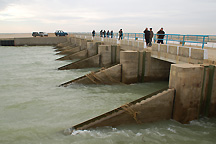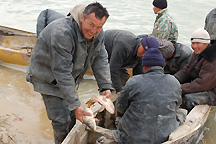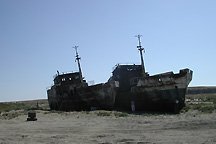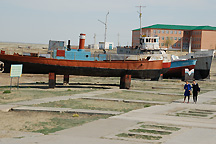 June 2006 - On a visit to a recently completed dike on the Northern Aral Sea in Kazakhstan this spring, there were grey clouds overhead. The sea was choppy and water flushed through a sluice, washing down fish into a channel leading towards the Southern Aral Sea. Fishermen who waited in row-boats just below the spillway netted large catches that would have seemed miraculous a year ago. June 2006 - On a visit to a recently completed dike on the Northern Aral Sea in Kazakhstan this spring, there were grey clouds overhead. The sea was choppy and water flushed through a sluice, washing down fish into a channel leading towards the Southern Aral Sea. Fishermen who waited in row-boats just below the spillway netted large catches that would have seemed miraculous a year ago.
The new dike, financed by the World Bank, has helped raise water levels in a once-dying sea. It has been called “the eighth wonder of the world” by the vice-mayor of Aralsk, a city of about 36,000 people famous for its landlocked harbor, rusty anchors and pathetic beached boats. Since it was completed last August, the eight-mile dike has raised water levels by an average of four meters in the Northern Aral Sea. That increase has revived local fisheries, restored hope in long-suffering communities and even affected the microclimate – clouds in May and rainstorms used to be unheard of in an area parched by decades of environmental abuse.  “These changes will translate into more local crops and better possibilities for livestock because there will be more fodder,” said Shigeo Katsu, the World Bank's Europe and Central Asia Vice President, after his visit in May. The sea, which had receded almost 100 km south of the port-city of Aralsk, is now a mere 25 km away. The countryside is greener. And the fisheries which were idle in town, now team again with fish ready to be chopped, frozen and shipped as far west as Ukraine. “These changes will translate into more local crops and better possibilities for livestock because there will be more fodder,” said Shigeo Katsu, the World Bank's Europe and Central Asia Vice President, after his visit in May. The sea, which had receded almost 100 km south of the port-city of Aralsk, is now a mere 25 km away. The countryside is greener. And the fisheries which were idle in town, now team again with fish ready to be chopped, frozen and shipped as far west as Ukraine.
These fisheries, which processed 20,000 tons of fish in the 1980s, were down to gutting 400 tons of salt-tolerant species (mainly flounder) because of the sea’s spectacular disappearing act. This year however the catch has increased tenfold and includes new species such as pike, perch and bream. “At camp Karateren where the dike’s construction workers live, villagers told us that people have stopped leaving and are starting to build houses again because they see new hope,” reported Katsu. News of the Aral Sea’s comeback has produced a rash of positive stories in the world’s media. The process that led to the construction of a successful dike was less glamorous, however. It took perseverance in the face of countless reversals. A protracted effort Previous multi-country and multi-million dollar efforts to save the Aral Sea had foundered on the logistical and political impossibility of getting eight countries to agree on a common course of action. Although the seashore is shared by only two countries, Kazakhstan in the north and Uzbekistan in the south, the Aral Sea Basin is fed by two large rivers – the Syr Darya and the Amu Darya - which run through the mountainous countries of Afghanistan, Tajikistan and the Kyrgyz Republic and through the plains of Uzbekistan, Kazakhstan and Turkmenistan.  “In the 1990s, Aralsk city officials grew weary of missions pouring in from all over the world to gawk at their environmental disaster. The solutions they proposed were often very conjectural, academic and far fetched,” says Ahmad. This skepticism towards international efforts was reflected in a statement by the Mayor of Aralsk who said at the time that “if every expert who visited the Aral Sea had brought a bucket of water, the Sea would have filled up already.” “In the 1990s, Aralsk city officials grew weary of missions pouring in from all over the world to gawk at their environmental disaster. The solutions they proposed were often very conjectural, academic and far fetched,” says Ahmad. This skepticism towards international efforts was reflected in a statement by the Mayor of Aralsk who said at the time that “if every expert who visited the Aral Sea had brought a bucket of water, the Sea would have filled up already.”
The current Northern Aral Sea project is part of an Aral Sea Basin Program that got off the ground in 1994 and comprises eight programs and 20 projects, including the Bank-supported project. The dike itself builds on previous crude attempts by local residents to hold back the disappearing Northern Sea with temporary sand barriers which were eventually washed away. Built in the same location, the new dike’s gentle beach slope is more environmentally-friendly, cheaper and less erosion-prone than a hard-edged dam. Think globally, act locally “Ultimately, discrete national investment projects are proving pivotal to the success of larger regional or multi-country plans,” remarks Ahmad. “You can agree on broad regional principles and have a consistent Aral Sea Basin Program, but it only works if you can break up the work program into pieces that can be implemented locally. Ownership at the local and national level is essential to achieve concrete results.” Beyond the dike, the Northern Aral Sea owes its partial recovery to the rehabilitation of the Shardara dam and other major hydraulic works along the Kazakh portion of the Syr Darya River Basin.  | The dry harbor of Aralsk |
A large part of the project’s benefits are expected to materialize along the river, far from the sea. As more water becomes available for irrigation and fields are better protected from floods, more farmers are likely to place additional land in production. Ahmad estimates that the project will benefit an estimated 1 million people who live mainly in Kzyl Orda Oblast, one of Kazakhstan’s poorest regions.
The next step is to improve the irrigation efficiency of two-thirds of the land in the Kazakh part of the Aral Sea Basin. Additional waterworks are planned to restore wetlands and fishing lakes in the delta region. And the mayor of Aralsk has a special request: he’d like Phase Two of the World Bank project to bring the sea back to the city’s harbor, possibly by building a second dam. * * *
Photographs by Brigitte Brefort |

